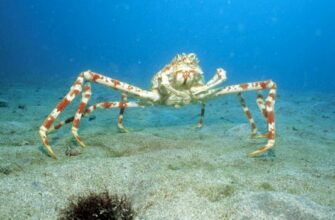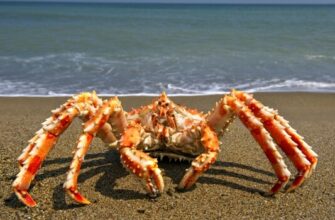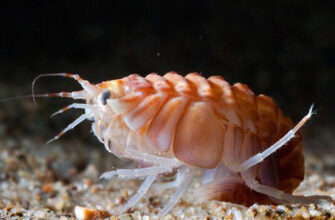Daphnia is a small crayfish that lives mostly in fresh water bodies of the planet. With their miniature size, they have a rather complex structure and serve as an important element of the ecosystem – multiplying rapidly, they allow fish and amphibians to feed, so that without them, reservoirs would be much more empty. They are also fed to fish in the aquarium.
Origin of the species and description
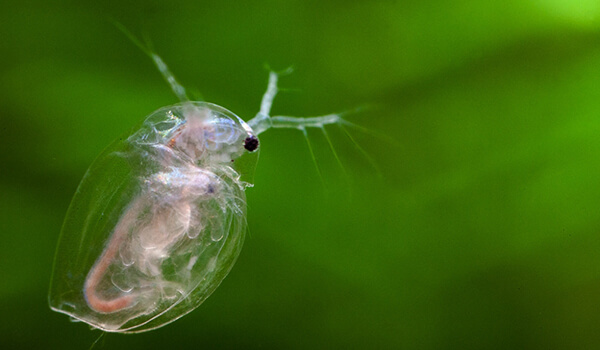
Photo: Daphnia
The genus Daphnia was described in 1785 made him O.F. Muller. There are about 50 species of daphnia, and many of them have significant differences from others. Daphnia longispina, described by the same Müller, is used as a type species.
Daphnia is divided into two large subgenera – Daphnia proper and Ctenodaphnia. The latter differ in a number of ways, for example, the presence of a recess in the head shield, and in general have a more primitive structure. But this does not mean that they occurred earlier: fossils place the origin of both at about the same time.
Video: Daphnia
The first representatives of the branchiopods appeared about 550 million years ago, among them were the ancestors of Daphnia. But they themselves arose much later: the oldest fossils belong to the lower Jurassic period – that is, they are approximately 180-200 million years old.
These are not as ancient times as one would expect from relatively simple organisms – for example, fish and birds appeared much earlier. But, like other representatives of the cladoceran superorder, already in those days daphnia were similar to the current ones, and in this they differ from more highly organized organisms of the same antiquity.
At the same time, one should not think that daphnia do not evolve: on the contrary, they have a high evolutionary variability and adaptability, and constantly give rise to new species. The final formation of the Daphnia genus occurred immediately after the extinction at the end of the Cretaceous.
Appearance and features
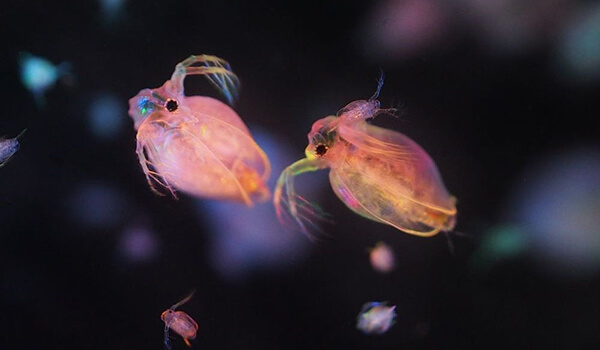
Photo: Daphnia moina
Species of daphnia can vary greatly : The shape of their body, as well as its size, is determined by the conditions of the environment in which they live. However, some common features can be identified. So, their body is covered with a chitinous shell with transparent valves – the internal organs are clearly visible. Due to the transparency in the water, daphnia are less visible.
The shell does not cover the head. It has two eyes, although often as they grow they merge into one compound eye, and sometimes Daphnia has a third, but usually it stands out clearly and is smaller. On the sides of the antennae, Daphnia constantly waves them, and with their help they move in jumps.
On the head, a rostrum is an outgrowth resembling a beak, and under it are two pairs of antennae, the posterior ones being larger and having bristles, due to which their area increases. With the help of the swings of these antennas, movement is carried out – when rowing them, the daphnia flies forward sharply, as if making a jump. These antennae are well developed and have strong muscles.
The body is laterally flattened, the legs are flattened and underdeveloped, because they are not used for movement. Mainly used to bring fresh water to the gills and food particles to the mouth. The digestive system is quite complicated for such a small crustacean: there is a full-fledged esophagus, stomach and intestines, in which there are liver outgrowths.
Daphnia also has a heart that contracts at a high speed – 230-290 beats per minute, resulting in blood pressure of 2-4 atmospheres. Daphnia breathes with the entire covering of the body, but primarily with the help of respiratory appendages on the limbs.
Where does daphnia live?
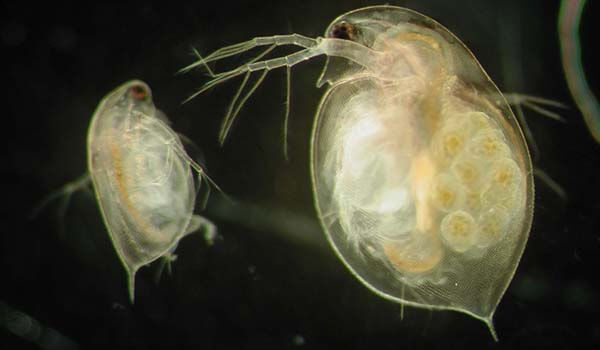
Photo: Daphnia magna
Representatives of the genus can be found almost all over the Earth. They were found even in Antarctica in samples taken from relict subglacial lakes. This means that daphnia are able to live in almost any natural environment presented on our planet.
However, if a century ago it was believed that all their species are ubiquitous, then it was found that each of them has its own range. In many species, they are quite wide and include several continents, but still there is not one that is common everywhere.
They inhabit the Earth unevenly, preferring the weather conditions of the subtropics and the temperate zone. There are noticeably fewer of them both at the poles of the planet and near the equator, in a tropical climate. The ranges of some species have undergone significant changes recently due to the fact that they are distributed by people.
For example, Daphnia ambigua came from America to Great Britain and successfully took root. On the contrary, the species Daphnia lumholtzi was brought to North America from Europe, and became common for the reservoirs of this continent.
For the habitat of daphnia, water bodies without a current, such as ponds or lakes, are preferred. Often they live in large puddles. In slowly flowing rivers, they are much less common, and almost never found in fast rivers. Most species live in fresh water.
But the ability to adapt was also manifested here: daphnia, which once found themselves in arid conditions, where only salty reservoirs were available to them, did not die, but developed resistance. Now, the species descended from them are characterized by a preference for water bodies with a high salt content.
They live best in clean water – it should have as little groundwater as possible. After all, daphnia feed by filtering water and, if it is dirty, soil particles enter their stomach along with microorganisms, which means that they die much faster in polluted reservoirs due to clogging of the stomach.
Therefore, by the number of daphnia in the reservoir, one can judge how clean the water is in it. They live mainly in the water column, and some species even at the bottom. They do not like bright lighting and go deeper when the sun starts to shine directly on the water.
What does daphnia eat?
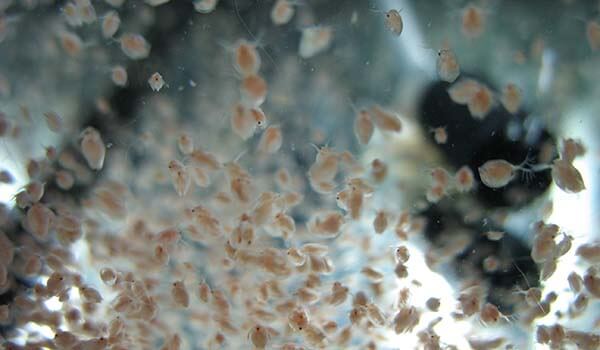
Photo: Daphnia in the aquarium
In their diet:
- ciliates;
- algae;
- bacteria;
- detritus;
- other micro-organisms floating in the water or lying on the bottom.
They feed by filtering water, for which they move their legs, making it flow. Filtration of the incoming water flow is carried out by special fans on the filter bristles. Then the absorbed particles stick together into a lump due to secretion processing and are sent to the digestive system.
Daphnia are notable for their voracity: in just one day, some species eat 6 times their own weight. Therefore, with a decrease in the amount of food, there are fewer of them in the reservoir – this happens when cold weather sets in, but most of all, daphnia becomes in late spring and summer.
Those species of daphnia that do not hibernate in winter feed on detritus. They spend winter at the bottom of the reservoir and in layers of water close to it – it is detritus that prevails from food there, that is, particles of tissues or secretions of other living organisms.
They themselves are used as food for fish in an aquarium – they are very useful due to the fact that in their stomachs a lot of plant foods. Daphnia are both given dry and launched alive into the aquarium. The latter is also useful if the water in it becomes cloudy: daphnia eat the bacteria that cause this to happen, and fish, in turn, eat daphnia.
Features of character and lifestyle
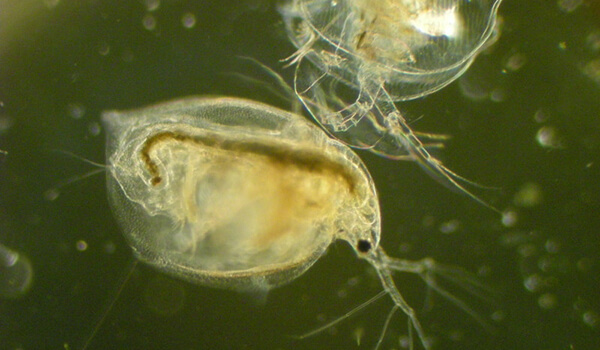
Photo: Daphnia crustaceans
They are mainly found in the water column, moving with the help of jumps, sometimes crawling along the bottom of the reservoir or the walls of the aquarium. They often move depending on what time of day it is: when it is light, they go deeper into the water, and at night they find themselves at the very edge.
A lot of energy is expended on these movements, therefore they must have a reason. However, it has not yet been possible to find out exactly. There are several most likely assumptions. For example, that large daphnia are forced to sink deeper during the day in order to become less noticeable to predators – after all, the deep layers of water are worse lit.
This assumption is confirmed by the fact that in water bodies where there are no fish feeding on daphnia, such migrations occur much less frequently. There is a simpler explanation – that daphnia simply tend to that layer of water where the temperature and illumination are optimal for them, and during the day it moves up and down.
The duration of their life. Usually the pattern is simple – the largest and live longer. Small daphnia are given 20-30 days, the largest up to 130-150 days.
An interesting fact: It is customary to test the level of toxicity of various solutions on daphnia. They react even to low concentrations – for example, they can become slower or sink to the bottom.
Social Structure and Reproduction
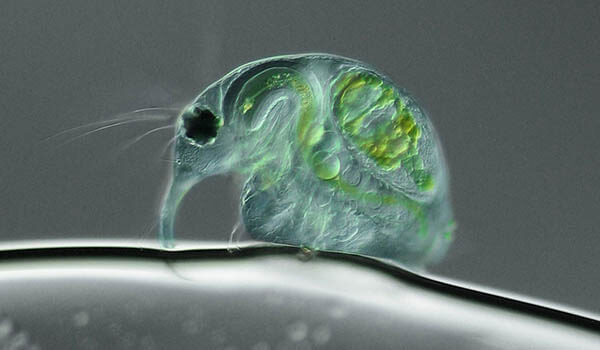
Photo: Daphnia
Daphnia are very prolific, and their reproduction is interesting in two stages – they reproduce both asexually and sexually. In the first case, only females participate in it and parthenogenesis is used. That is, they reproduce themselves without fertilization, and their offspring receive the same genotype as the single parent. It is thanks to parthenogenesis, when good conditions come, that their number in the reservoir increases significantly in the shortest possible time: usually this method of reproduction in daphnia is activated at the end of spring and summer, when there is most food for them.
Reproduction in this case takes place so: eggs are laid in a special cavity and develop without fertilization. After their development ends and a brood of new daphnia appears, the female molts, and after only 3-6 days she can start a new cycle. By that time, the females that appeared last time are also ready to breed.
Considering that dozens of new daphnia appear in each brood, their number in the reservoir is growing at a very fast pace, and in just a couple of weeks it can be full – this becomes noticeable by the reddish tint of the water. If food begins to be scarce, males appear in the population: they are smaller and faster than females, and are also distinguished by some other structural features. They fertilize females, as a result of which eggs appear in the so-called ephippia – a strong chitinous shell that allows you to survive adverse conditions.
For example, they do not care about cold or drying up of a reservoir, they can be carried by the wind along with dust, and do not die when passing through the digestive system of animals. Even being in solutions of toxic salts is nothing to them, their shell is so reliable.
But, if breeding by parthenogenesis for Daphnia is simple, then bisexual reproduction requires much more effort, and in many species, females even die after laying eggs. After falling into favorable conditions, the next generation of Daphnia hatches from the eggs and reproduces again by parthenogenesis. Moreover, only females appear, since males do not experience adverse conditions.
Now you know how to breed daphnia. Let's see what dangers await Daphnia in the wild.
Natural enemies of Daphnia
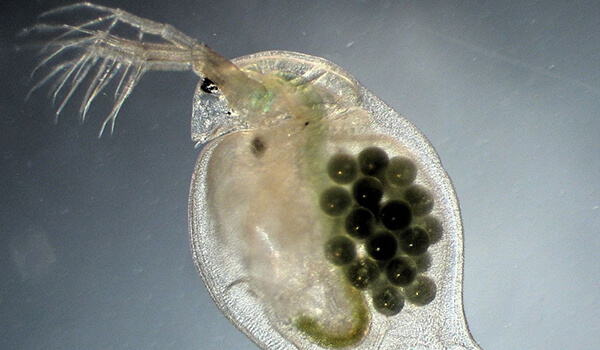
Photo: Daphnia eggs
Such small and defenseless creatures have many enemies – predators that feed on them.
These are:
- small fish;
- fry;
- snails;
- frogs;
- larvae of newts and other amphibians;
- other predatory inhabitants of water bodies.
Large and even medium-sized fish are practically not interested in daphnia – for it it is too small prey, which requires too much to saturate. But a trifle is another matter, for small fish, if there are a lot of daphnia in the reservoir, they serve as one of the main sources of food.
This is especially true for large species, because for small daphnia their very size serves as protection – to chase behind a crustacean half a millimeter, even a small fish will not, another thing is large individuals of 3-5 mm. It is the fish that is the main predator that exterminates daphnia, and the fry of larger fish also feed on them. For them, daphnia is also one of the main sources of food.
But even if there are no fish in the reservoir, they are still threatened by many dangers: large individuals are eaten by frogs and other amphibians, and their larvae also eat small ones. Snails and other predatory mollusks feed on daphnia – although daphnia may try to “jump” from some of them, unlike much more dexterous fish.
An interesting fact: Deciphering the Daphnia genome revealed a lot of interesting things to scientists: approximately 35% of the gene products found in the genome are unique, while being very sensitive to any change in the environment. This is what makes Daphnia adapt so quickly.
Population and species status
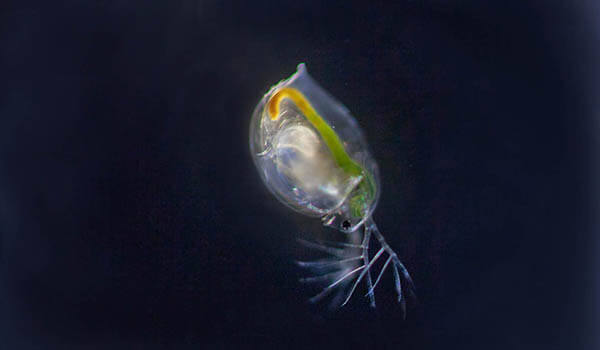
Photo: Daphnia in water
The number of daphnia living in the waters of the world cannot be calculated – it is only clear that it is very large and nothing threatens the survival of this genus. They live all over the planet, in a variety of conditions, changing and adapting even to those in which they could not survive before. Even bringing them out on purpose can be a daunting task.
Thus, they have the status of the least threatened and are not protected by law, they can be freely caught. This is what many owners of aquariums do, for example. After all, if you buy dry daphnia for fish food, they can be caught in polluted and even toxic water bodies.
They are often caught for sale in dirty water near sewage treatment plants – there are no fish there, and therefore they are bred most actively . This once again testifies to how tenacious they are, but it forces you to carefully choose where to catch them from, otherwise the fish may be poisoned. Daphnia caught in a clean reservoir and launched into an aquarium will be an excellent top dressing for them.
Interesting fact: Generations of daphnia can differ markedly in body shape depending on what season they develop. For example, in summer generations, the helmet on the head and the needle on the tail are often elongated. To grow them, you need to spend more energy, as a result, the fecundity of an individual decreases, but this is justified by the fact that the outgrowths protect against predators.
In summer, predators become especially numerous, and because behind these outgrowths, it becomes more difficult for some of them to grab daphnia, sometimes, in addition, their tail needle breaks, due to which the daphnia manages to slip out. At the same time, the outgrowths are transparent, and therefore it does not become easier to notice because of them.
Daphnia — a small and inconspicuous inhabitant of ponds, lakes and even puddles, performing several necessary functions at once, moreover, their study is very important for scientists. Yes, and they are familiar to aquarium owners firsthand – you can not only give dried daphnia to fish, but also get these crustaceans themselves so that they purify the water.

